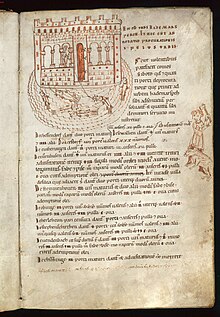Codex Falkensteinensis
The Codex Falkensteinensis (also Codex diplomaticus Falkensteinensis or Falkensteiner Codex ) is an important medieval manuscript that is in the Bavarian Main State Archives in Munich . The pen book was in 1166 as a land register and feudal directory of canons of the pen Herrenchiemsee at the instigation of the Count of Neuburg-Falkenstein written. The work, which was created in the Falkensteiner Burg Neuburg near Vagen , is considered the only surviving traditional book of secular rule from the Staufer period .
Historical and legal significance
In the Falkensteiner Codex, written in Latin, the possessions of the Lords of Neuburg-Falkenstein are listed, which at that time included, apart from the heartlands in the Inn Valley and in the valley of the Große Vils, large estates between the Upper Bavarian Mangfall Valley , today's South Tyrol and Lower Austria . Siboto IV had the book written before he took part in Frederick Barbarossa's fourth campaign in Italy in order to secure ownership for his underage children if he should perish on the journey.
The Falkensteiner Codex contains regulations on the guardianship of the Count's children and a list of the passive loans and allodial property of the Falkensteiner family. More recent supplements include entries on various types of legal transactions, income lists, and family history notes.
A special feature is the copy of a secret letter from Sibotos IV to his Lower Austrian servant Ortwin von Merkenstein , in which he instructs him to eliminate his enemy Rudolf von Piesting . It is not clear from the wording of the letter whether Siboto commissioned a murder or a blinding . In the end, it is also not clear whether Siboto's murder letter is genuine and whether the act may have been carried out or whether it is a forgery for the purpose of denigrating Siboto's. Finally, there is also the possibility that the letter was actually written by Siboto, but withheld to serve as a means of pressure for his relatives in Lower Austria.
Art historical aspects
The Falkensteiner Codex is equipped with illustrations and miniatures that are shaped by the transition from the Byzantine style of painting to European-medieval illumination.
The beginning of the manuscript is illustrated with a pictorial representation of the count family, which depicts Count Siboto IV , his wife Hildegard von Mödling and the sons Kuno and Siboto V. and is considered one of the oldest family pictures. In four other half-page miniatures , the castles of the family are shown in red and brown: fol. 2v the Neuburg, fol. 6v Falkenstein , fol. 11 Hartmannsberg (Hademarsberg) and fol. 14 Hernstein in Lower Austria. There are also numerous marginal illustrations of animals and farmers.
literature
- K. Weidemann: Courtyard, castle and town in eastern Upper Bavaria during the early and high Middle Ages . In: Römisch-Germanisches Zentralmuseum Mainz (Hrsg.): Guide to prehistoric and early historical monuments . Volume 18: Miesbach, Tegernsee, Bad Tölz, Wolfratshausen, Bad Aibling . Verlag Philipp von Zabern, Mainz am Rhein 1971.
- Elisabeth Noichl: Codex Falkensteinensis. The legal records of the Counts of Falkenstein . Beck, Munich 1978, ISBN 3-406-10388-X , ( sources and discussions on Bavarian history NF 29).
- Werner Rösener : Codex Falkensteinensis. On the culture of remembrance of a noble family in the High Middle Ages . In: Werner Rösener: (Ed.): Noble and bourgeois cultures of remembrance of the late Middle Ages and early modern times . Vandenhoeck & Ruprecht, Göttingen 2000, ISBN 3-525-35427-4 , ( forms of memory 8), pp. 35–55.
Web links
- Online edition of the Codex Falkensteinensis (KL Weyarn 1) and the edition by Elisabeth Noichl at the Bayerische Landesbibliothek Online
- Digitized version of the Codex Falkensteinensis in the culture portal bavarikon
- Summary description of the University of Klagenfurt
Individual evidence
- ↑ a b Peter Bergmaier (1966): Codex diplomaticus Falkensteinensis, German translation. The Mangfallgau 11: 5-68
- ↑ Patrick J. Geary, John B. Freed (2008). Literacy and Violence in Twelfth-Century Bavaria: The "Murder Letter" of Count Siboto IV. Viator 25, 115-130. doi : 10.1484 / J.VIATOR.2.301210
- ^ Hans Petz, Hermann von Grauert and Johannes Mayerhofer: Three Bavarian traditional books from the XII. Century: Festschrift for the 700th anniversary of Wittelsbach's accession to the throne. Published by Max Kellerer, Munich 1880

